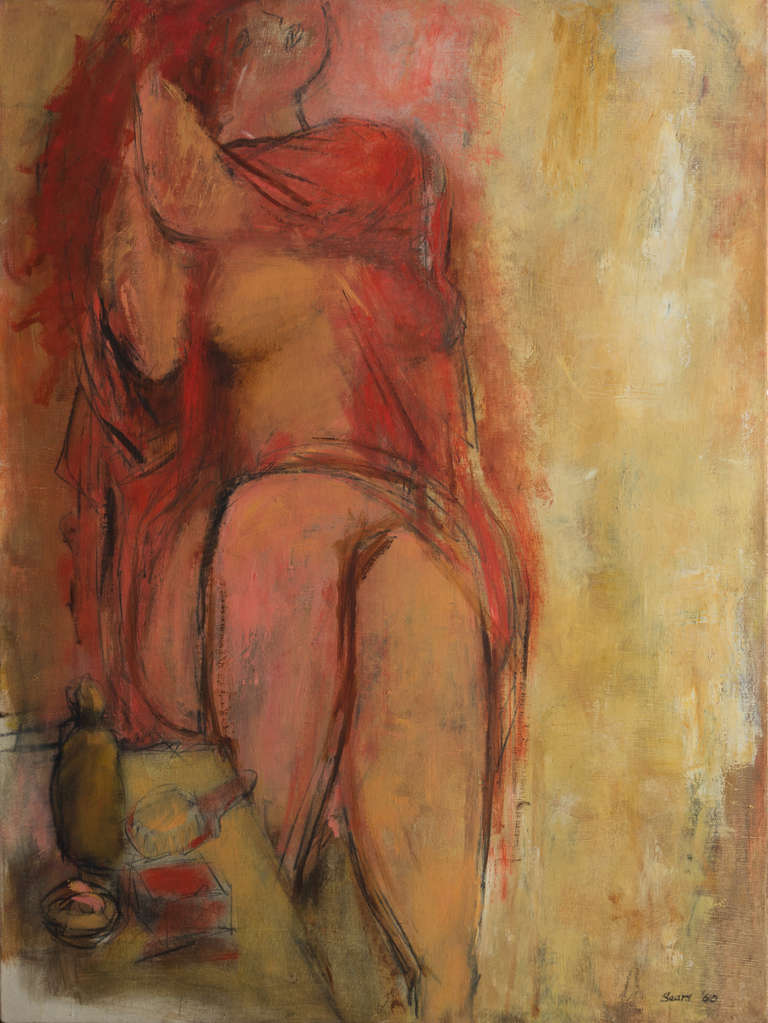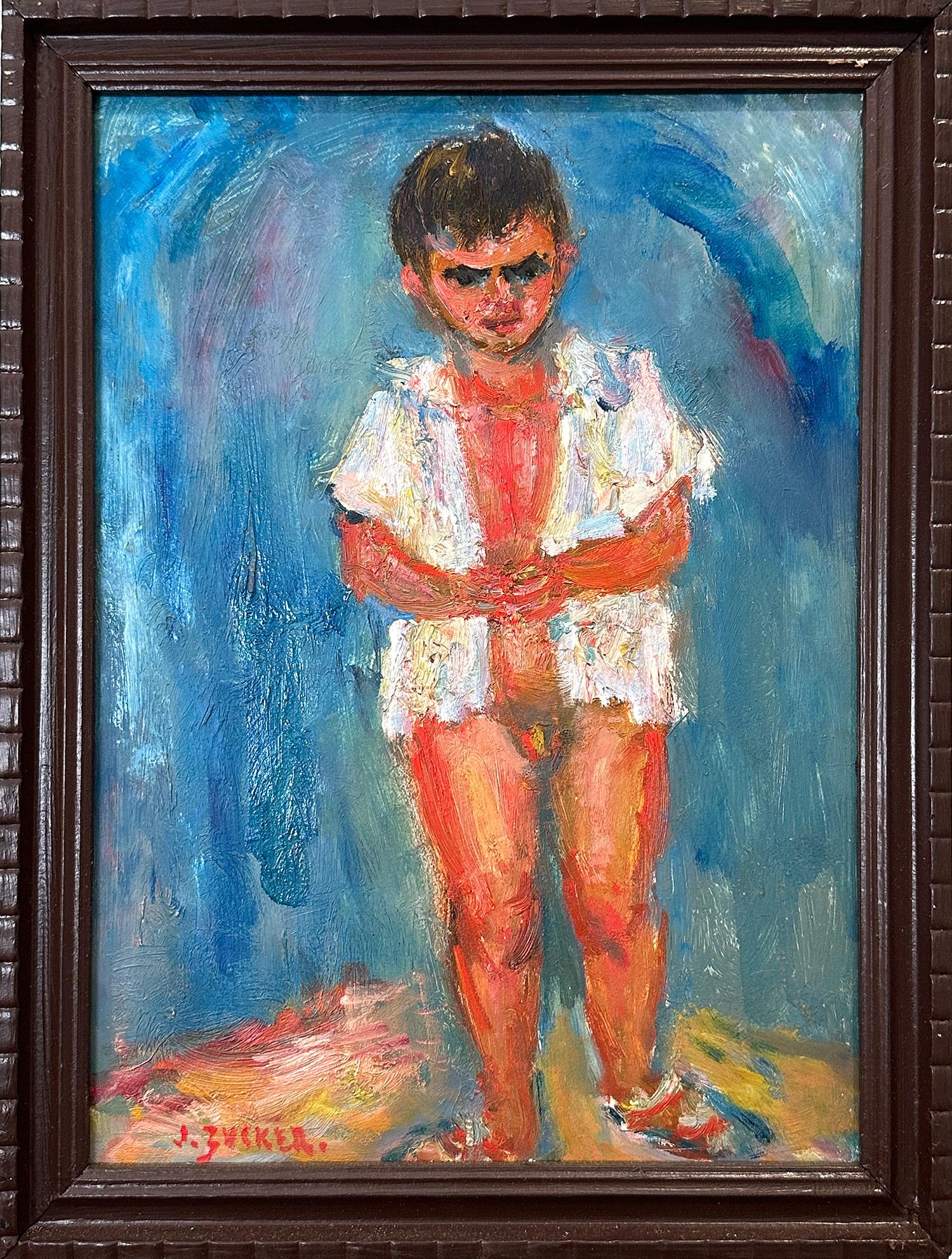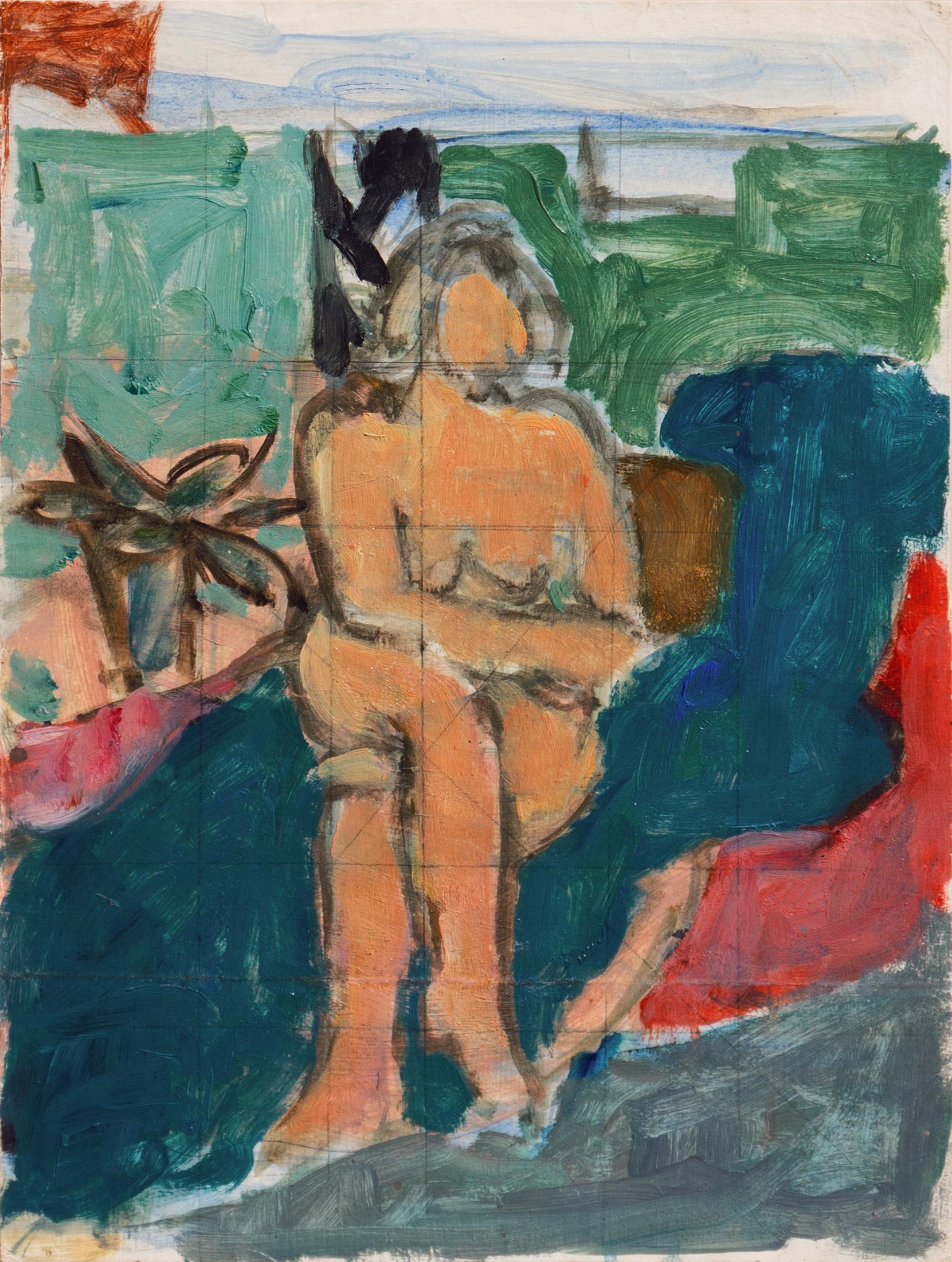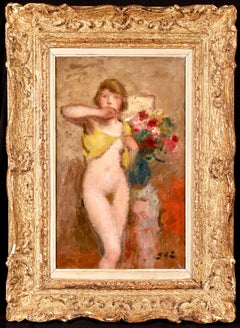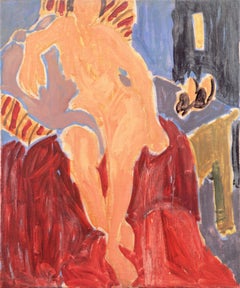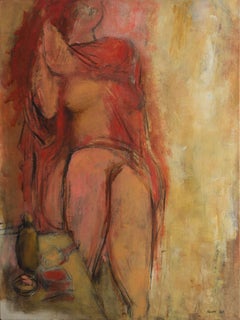
Femme Nu - Post Impressionist Oil, Nude Figure in Interior - Henri Lebasque
View Similar Items
Want more images or videos?
Request additional images or videos from the seller
1 of 12
Henri LebasqueFemme Nu - Post Impressionist Oil, Nude Figure in Interior - Henri Lebasquec.1920
c.1920
About the Item
- Creator:Henri Lebasque (1865-1937, French)
- Creation Year:c.1920
- Dimensions:Height: 32 in (81.28 cm)Width: 28 in (71.12 cm)
- Medium:
- Movement & Style:
- Period:
- Condition:Very good original condition.
- Gallery Location:Marlow, GB
- Reference Number:Seller: LFA03171stDibs: LU41539511972
About the Seller
5.0
Platinum Seller
These expertly vetted sellers are 1stDibs' most experienced sellers and are rated highest by our customers.
Established in 2001
1stDibs seller since 2016
668 sales on 1stDibs
Typical response time: 3 hours
More From This SellerView All
- Nu avec des fleurs - Post-Impressionist Oil, Nude & Flowers - Georges D'EspagnatBy Georges d'EspagnatLocated in Marlow, BuckinghamshireSigned nude oil on original canvas circa 1910 by French post impressionist painter Georges D'espagnat. The work depict a nude woman seated on a stall turned away from the artist. Paintings hang on the wall and there's a vase filled with pink and red flowers on the wooden mantlepiece beside her. Signature: Signed upper left Dimensions: Framed: 30"x26" Unframed: 22"x18" Provenance: Private French collection. Exhibition stamp verso From the beginning of his career, it was a constant concern of Georges d'Espagnet to assert his originality. His studies at the École des Arts Décoratifs, Paris, did not last very long, for he wanted immediate independence and decided to follow courses in the private academies of Montparnasse. In about 1900, he became acquainted with Maurice Denis, Bonnard and Vuillard, and his collaboration with Denis led to a renewal of religious art in France. In 1903, d'Espagnet was one of the founders of the Salon d'Automne, and was appointed professor in charge of studios at the École des Beaux-Arts, Paris, in 1934. He illustrated a number of books: Rémy de Gourmont's Evil Prayers ( Oraisons mauvaises) (1896), The Saints of Paradise ( Les Saintes du paradis) (1898), Simone (1907), Sistine ( Sixtine) (1922); Alphonse Daudet's The Immortal ( L'Immortel) (1930); André Gide's The Pastoral Symphony ( La Symphonie pastorale); Francis Jammes' Clearings in the Sky ( Chairières dans le ciel) (1948). D'Espagnet belongs to the group of artists who made the Courrier Français so successful. The drawings of his which are published in it are strongly expressive and some bear comparison with the designs of the great Renaissance masters. He also contributed to L'Image. He often placed cheerful nudes in a landscape, reminding us that, though he moved away from the Fauves, he retained their freedom of colour and arabesque. He painted many portraits, including those of Albert André, André Barbier...Category
1910s Post-Impressionist Nude Paintings
MaterialsCanvas, Oil
- Le Jardin D'Eden - Post Impressionist Oil, Nudes in Landscape by Paul E GernezBy Paul-Élie GernezLocated in Marlow, BuckinghamshireA wonderful oil on canvas circa 1920 by French post impressionist painter Paul Elie Gernez depicting nude figures in the garden of eden. Signature: S...Category
1920s Post-Impressionist Nude Paintings
MaterialsCanvas, Oil
- Nu avec des fleurs - Post-Impressionist Oil, Nude & Flowers - Georges D'EspagnatBy Georges d'EspagnatLocated in Marlow, BuckinghamshireA beautiful oil on original canvas circa 1910 by French post impressionist painter Georges D'Espagnat. The work depicats a nude woman in a yellow shawl standing by a blue vase filled with pink, red and white flowers. Signature: Signed lower right Dimensions: Framed: 28"x20" Unframed: 21"x13" Provenance: Doyle New York - May 2003 From the beginning of his career, it was a constant concern of Georges d'Espagnet to assert his originality. His studies at the École des Arts Décoratifs, Paris, did not last very long, for he wanted immediate independence and decided to follow courses in the private academies of Montparnasse. In about 1900, he became acquainted with Maurice Denis, Bonnard and Vuillard, and his collaboration with Denis led to a renewal of religious art in France. In 1903, d'Espagnet was one of the founders of the Salon d'Automne, and was appointed professor in charge of studios at the École des Beaux-Arts, Paris, in 1934. He illustrated a number of books: Rémy de Gourmont's Evil Prayers ( Oraisons mauvaises) (1896), The Saints of Paradise ( Les Saintes du paradis) (1898), Simone (1907), Sistine ( Sixtine) (1922); Alphonse Daudet's The Immortal ( L'Immortel) (1930); André Gide's The Pastoral Symphony ( La Symphonie pastorale); Francis Jammes' Clearings in the Sky ( Chairières dans le ciel) (1948). D'Espagnet belongs to the group of artists who made the Courrier Français so successful. The drawings of his which are published in it are strongly expressive and some bear comparison with the designs of the great Renaissance masters. He also contributed to L'Image. He often placed cheerful nudes in a landscape, reminding us that, though he moved away from the Fauves, he retained their freedom of colour and arabesque. He painted many portraits, including those of Albert André, André Barbier, Victor Boucher, Déodat de Séverac, Albert Marque...Category
1910s Post-Impressionist Nude Paintings
MaterialsCanvas, Oil
- Le Coucher - Post Impressionist Nude in Interior Oil Painting by Pierre de BelayBy Pierre de BelayLocated in Marlow, BuckinghamshireSigned and dated nude figure in interior oil on canvas by French post impressionist painter Pierre De Belay. This work depicts a painting of Pierre De Belay's wife - Helene. Here she...Category
1940s Post-Impressionist Nude Paintings
MaterialsOil, Canvas
- La Toilette - Post-Impressionist Nude Oil Painting by Georges D'EspagnatBy Georges d'EspagnatLocated in Marlow, BuckinghamshireSigned oil on original canvas nude circa 1914 by French post impressionist painter Georges D'espagnat. The work depict a nude woman standing beside a wash basin in a boudoir. Signature: Signed lower right Dimensions: Framed: 45"x34" Unframed: 37"x26" Provenance: Private collection - Netherlands From the beginning of his career, it was a constant concern of Georges d'Espagnet to assert his originality. His studies at the École des Arts Décoratifs, Paris, did not last very long, for he wanted immediate independence and decided to follow courses in the private academies of Montparnasse. In about 1900, he became acquainted with Maurice Denis, Bonnard and Vuillard, and his collaboration with Denis led to a renewal of religious art in France. In 1903, d'Espagnet was one of the founders of the Salon d'Automne, and was appointed professor in charge of studios at the École des Beaux-Arts, Paris, in 1934. He illustrated a number of books: Rémy de Gourmont's Evil Prayers ( Oraisons mauvaises) (1896), The Saints of Paradise ( Les Saintes du paradis) (1898), Simone (1907), Sistine ( Sixtine) (1922); Alphonse Daudet's The Immortal ( L'Immortel) (1930); André Gide's The Pastoral Symphony ( La Symphonie pastorale); Francis Jammes' Clearings in the Sky ( Chairières dans le ciel) (1948). D'Espagnet belongs to the group of artists who made the Courrier Français so successful. The drawings of his which are published in it are strongly expressive and some bear comparison with the designs of the great Renaissance masters. He also contributed to L'Image. He often placed cheerful nudes in a landscape, reminding us that, though he moved away from the Fauves, he retained their freedom of colour and arabesque. He painted many portraits, including those of Albert André, André Barbier, Victor Boucher, Déodat de Séverac, Albert Marque, André Marty and Albert Roussel. He also painted mural decorations, including a wall for the Palais de la Découverte (1937), the ceiling of the Victor Hugo Room in the Palais du Luxembourg (1939), a decorative panel for the Palais de Justice, Toulouse (1941) and interior decorations for private houses. His landscapes are Impressionist in inspiration, and work for a certain sobriety, an intimacy, both in their composition - one, two or three sketched figures and large open spaces - and in the choice of colours and treatment with the special hazy brushstroke that marks his style. D'Espagnet took part in a number of annual Parisian exhibitions, including the Salon des Indépendants, the Salon de la Société Nationale des Beaux-Arts, the Salon d'Automne (from 1903 to 1949, except in special circumstances), the Salon de la Libre Ésthétique, Brussels (1899, 1901), the Berlin Secessionists (1940). He also exhibited at the first Salon de la Société de la Gravure sur Bois. Among other exhibitions were 1912, A Century of French Art ( Centenaire de l'art français), St Petersburg; 1916, Kunstverein, Winterthur; 1918, 1926, Galerie M. Bertheim, Paris; 1930, Contemporary French Art...Category
1910s Post-Impressionist Nude Paintings
MaterialsOil, Canvas
- Nu sur la plage - Post Impressionist Oil, Nude in Landscape by Henri LebasqueBy Henri LebasqueLocated in Marlow, BuckinghamshireSigned oil on canvas circa 1920 by French post impressionist painter Henri Lebasque. The work depicts a nude brunette woman lying on a beach, her arm draped over her head covering her face. A beautifully brushed piece. Signature: Signed lower left Dimensions: Framed: 22"x27" Unframed: 13"x18" Provenance: With thanks to Denise Bazetoux for confirming the authenticity of this work This painting is included in the Catalogue Raisonne of Henri Lebasque - Volume I No. 1409 Maitre Blache, Versailles, 21st November 1967 Lot 117 Maitre Lombrail, Enghien-les-Bains, 23rd September 1984 Sotheby's, London, 1st July 1987 Lot 317 Miromesnil Fine Art, Paris - 1988 Henri Lebasque studied at the École des Beaux-Arts in Angers, then, after moving to Paris in 1886, studied briefly under Bonnat, then under Humbert, whom he assisted in the decoration of the Panthéon. More importantly, he met and learned from Pissarro. In 1893 he met Luce and Signac at the Salon des Indépendants, and as a result he adopted Pointillism for a few years. In the 1900s he lived in Lagny with his family and painted landscapes of the neighbouring Marne forest. His painting underwent drastic changes when he discovered the south of the country. He would thereafter live in other French regions: Vendée, Brittany and Normandy, where he stayed at Les Andelys for some time, but his home from home was between Sanary and Nice. He painted members of his family in the settings in which he lived, mostly in Provence. His work shares some themes of his friend Bonnard. But although he exhibited with the Fauves, and admired Matisse, Rouault, Dufy, Valtat and Manguin (who introduced him to the Midi), he remained distinct from them in style. Lebasque was well known in his lifetime. He collaborated on the decorations of the Théâtre des Champs-Élysées and of the Atlantic liner Paris. He is remembered for: Nymphs at their Bath; The Sunshade; Girl with Hydrangeas; Great Nude on a Pink Sofa. He took part in the following collective exhibitions: Salon des Indépendants, 1886; Salon des Artistes Français; and later the Salon d'Automne, of which he was a founding member in 1903 and on whose committee he sat until his death. A set of his works was shown in 1937 at Masters of Independent Art ( Maîtres de l'Art Indépendant) at the Petit Palais. In 1957, 20 years after his death, a retrospective exhibition was held at the Musée des Ponchettes in Nice, and in 1981 his works were exhibited at St-Paul-de-Vence. Museum and Gallery Holdings Angers: The Artist's Mother Geneva (Petit Palais): The Child's Toilette (1900) Lille (MBA): Notre-Dame under Snow Nantes: Vallée de la Garde Paris (MAM): The Cigarette; Nude; Woman with NecklaceCategory
1920s Post-Impressionist Nude Paintings
MaterialsCanvas, Oil
You May Also Like
- The painter and the Model oil on canvas painting fauvism nudeBy Jordi CurosLocated in Barcelona, BarcelonaJordi Curós Ventura (1930-2007) - the painter and the Model - Oil on canvas. Work measurements 61x46 cm. Frameless. Jordi Curós Ventura (Olot, Girona, March 4, 1930) is a Spanish pa...Category
1970s Fauvist Nude Paintings
MaterialsOil, Canvas
$672 Sale Price22% Off - 'Seated Nude', Paris, Louvre, Academie Chaumiere, Carmel, California, LACMA, OilBy Victor Di GesuLocated in Santa Cruz, CAStamped, verso, with the estate stamp for Victor Di Gesu (American, 1914-1988) and painted circa 1958. A substantial, Post-Impressionist style figural oil showing a young woman seat...Category
1960s Post-Impressionist Nude Paintings
MaterialsCanvas, Oil
- 'Nude in Ivory and Coral', Large Mid-Century Expressionist Figural OilBy Sears, Roebuck & CompanyLocated in Santa Cruz, CASigned lower right "Sears" (American, 20th century) and dated 1960. A substantial, Expressionist style figural oil showing a partially-draped woman seated at a dressing-table and br...Category
1960s Post-Impressionist Nude Paintings
MaterialsCanvas, Oil
- Nude in Life Class with Green Shoes - British 40's Slade School art oil paintingBy E.A. JayLocated in London, GBThis superb Post Impressionist Slade School female full length seated nude portrait oil painting is by female artist E A Jay. Painted in the 1940'...Category
1940s Post-Impressionist Nude Paintings
MaterialsOil
- Tin Bath - British 40's art Post-Impressionist interior oil nude self portraitBy Jean YoungLocated in London, GBA stunning Post Impressionist portrait of a girl washing in The Tin Bath by the female artist Jean Young. I believe this is a self portrait as there is a pot of artists brushes in t...Category
20th Century Post-Impressionist Nude Paintings
MaterialsOil
- "Nude Boy with Open Shirt" French Blue Post-Impressionist Oil Painting FramedBy Jacques ZuckerLocated in New York, NYThis painting depicts a whimsical scene of a nude boy wearing an open shirt and sandals. The bright colors and quick brush strokes are what makes this painting so attractive and desi...Category
20th Century Post-Impressionist Interior Paintings
MaterialsOil, Board

